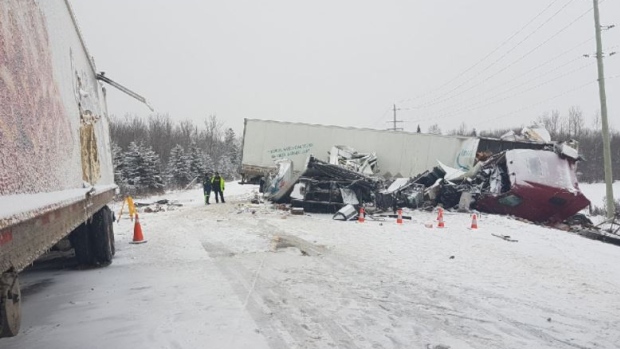4 fatalities from 3 crashes on provincial highways in northeast during first week of new year

One man died in a serious collision on Highway 11 near Earlton, Ont., on Wednesday. Three other people were also killed in collisions in the northeast. (OPP/Twitter)
Morning North
What can be done to make our highways safer?
Highways in northeastern Ontario present distinct challenges when it comes to preventing collisions, according to an expert who once helped police roadways in the region.
Four people died in three separate crashes last week on OPP-patrolled highways in the region. Police are still investigating the cause of each collision.
Mark Andrews, a retired traffic inspector, says he’s tired of hearing about these kinds of stories in the news.

Mark Andrews worked as a traffic inspector for the OPP for 32 years. He now he consults with organizations like the Traffic Injury Research Foundation on traffic safety. (Supplied)
He says distracted driving is one of the biggest safety concerns right now, adding that it becomes an even bigger problem in this part of the province.
“The highways in our region — in northeastern Ontario and northwestern Ontario — are two lane highways. You have long distances between communities because of how the north has been developed,” Andrews says.
“You have everything being stuffed into this pipe.”
Driving is becoming more complicated
Although there has been the same conversations about highway safety happening for the past decade, Andrews says not enough has been done to prevent fatalities.
“I hear the same issues being raised again and again of the cause [of collisions]…and ideas being raised that were raised 10 years ago.”
At the same time, Andrews says driving is becoming more complicated than ever before as cars become entertainment systems. Andrews cites one example of a manufacturer that is developing an app so you can order coffee from your car.
“The roads haven’t been developed, the cars haven’t been developed and the users haven’t kept up with what we now have for a vehicle to drive in,” Andrews says.
“We’re not going to back up the clock. Technology won’t let us do that.”
The infrastructure just hasn’t kept up with those changes.
Andrews says some quick fixes in the northeast include installing centre-line rumble strips along two-lane highways and improving winter maintenance.
He adds more long-term solutions require cooperation between governments, vehicle manufacturers and other key stakeholders, like the trucking industry.
“How many times do we all get into the same room and talk about, ‘Here’s the issues. What can you do? What’s your role in this to stop this from happening?’ And I have never seen that happen,” Andrews says.
“We [have to] get together to move this forward, so that we don’t have to go to funerals.”
Source: CBC News
